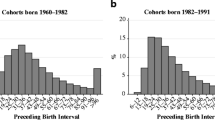Abstract
Newlywed spouses (N=215 couples) were tested on 21 tests of specific cognitive abilities and responded to a questionnaire on their educational and socioeconomic (SES) background. A comparison of the present spouse correlations with those of long-standing marriages suggests that spouses resemble each other in abilities from the start and that the degree of resemblance changes little over time. The low spouse correlations for SES of origin (their parents) suggests that education is the chief SES variable by which spouse selection takes place. Spouse resemblance in education and parental SES could explain almost all of the spouse correlations in perceptual speed and spatial ability. However, a small but significant degree of spouse similarity in verbal and reasoning abilities was independent of education and SES.
Similar content being viewed by others
References
Acker, J. (1973). Women and social stratification: A case of intellectual sexism. In Huber, J. (ed.),Changing Women in a Changing Society, University of Chicago Press, Chicago, pp. 174–183.
Anastasi, A. (1976).Psychological Testing (4th ed.), MacMillan, New York.
Blau, P. M., and Duncan, O. D. (1967),The American Occupational Structure, John Wiley and Sons, New York.
Chase, I. D. (1975). A comparison of men's and women's intergenerational mobility in the U.S.Am. Sociol. Rev. 40:483–505.
Cooley, W. W., and Lohnes, P. R. (1971).Multivariate Data Analysis, John Wiley and Sons, New York.
Crow, J. F., and Kimura, M. (1970).An Introduction to Population Genetics Theory, Harper and Row, New York.
Eckland, B. K. (1970). New mating boundaries in education.Soc. Biol. 17:269–277.
Gulliksen, H. (1950). The reliability of speeded tests.Psychometrika 15:259–269.
Guttman, L. (1945). A basis for analyzing test-retest reliability.Psychometrika 10:255–282.
Harrison, G. A., Gibson, J. B., and Hiorns, R. W. (1976). Assortative marriage for psychometric personality, and anthropometric variation in a group of Oxfordshire villages.J. Biosoc. Sci. 8:145–153.
Hudson, J. W., and Henze, L. F. (1969). Campus values in mate selection: A replication.J. Marr. Fam. 31:772–775.
Jensen, A. R. (1978). Genetic and behavioral effects of nonrandom mating. In Osborne, R. T., Noble, C. E., and Weyl, N. (eds.),Human Variation: Biopsychology of Age, Race, and Sex, Academic Press, New York, pp. 51–105.
Johnson, R. C., DeFries, J. C., Wilson, J. R., McClearn, G. E., Vandenberg, S. G., Ashton, G. C., Mi, M. P., and Rashad, M. N. (1976). Assortative marriage for specific cognitive abilities in two ethnic groups.Hum. Biol. 48:343–352.
Johnson, R. C., Park, J., DeFries, J. C., Ashton, G. C., McClearn, G. E., Mi, M. P., Rashad, M. N., Vandenberg, S. G., and Wilson, J. R. (1977). Assortative marriage for specific cognitive abilities in Korea.Soc. Biol. 23:311–316.
Johnson, R. C., Ahern, F. M., and Cole, R. E. (1980). Secular change in degree of assortative mating for ability?Behav. Genet. 10:1–8.
Lin, N. (1976).Foundations of Social Research, Appendix B, McGraw-Hill, New York, pp. 415–427.
Michielutte, R. (1972), Trends in educational homogamy.Sociol. Educ. 45:288–302.
Papanek, H. (1973). Men, women and work: Reflections on the two-person career. In Huber, J. (ed.),Changing Women in a Changing Society, University of Chicago Press, Chicago.
Price, R. H., and Vandenberg, S. G. (1980). Spouse similarity in American and Swedish couples.Behav. Genet. 8:59–72.
Rockwell, R. C. (1976). Historical trends and variation in educational homogamy.J. Marr. Fam. 38:83–95.
Siegel, P. M. (1971),Prestige in the American Occupational Structure, Unpublished Ph.D. dissertation, University of Chicago, Chicago.
Spuhler, J. N. (1968). Assortative mating with respect to physical characteristics.Eugen. Quart. 15:128–140.
U.S. Bureau of the Census (1971).1970 Census of Population Alphabetical Listing of Industries and Occupations, U.S. Government Printing Office, Washington, D.C.
U.S. Department of Labor, Bureau of Labor Statistics (1976).Geographic Profile on Employment and Unemployment in 1974, Report No. 452.
U.S. Department of Labor, Manpower Administration, Data Systems and Reports, Region Nine (1972)1970 Census of Population Summary Manpower Indicators for Alameda and Contra Costa Counties in California, Manpower Package No. 1, Tables 1 and 2, unpublished data available on microfiche, Institute of Governmental Studies Library, University of California, Berkeley.
Vandenberg, S. G. (1972). Assortative mating, or who marries whom?Behav. Genet. 2:127–157.
Warren, B. L. (1966). A multiple variable approach to the assortative mating phenomenon.Eugen. Quart. 13:285–290.
Wilson, J. R., DeFries, J. C., McClearn, G. E., Vandenberg, S. G., Johnson, R. C., and Rashad, M. N. (1975). Cognitive abilities: Use of family data as a control to assess sex and age differences in two ethnic groups.Int. J. Aging Hum. Dev. 6:261–276.
Zonderman, A. B., Vandenberg, S. G., Spuhler, K. P., and Fain, P. R. (1977). Assortative marriage for cognitive abilities.Behav. Genet. 7:261–271.
Author information
Authors and Affiliations
Rights and permissions
About this article
Cite this article
Watkins, M.P., Meredith, W. Spouse similarity in newlyweds with respect to specific cognitive abilities, socioeconomic status, and education. Behav Genet 11, 1–21 (1981). https://doi.org/10.1007/BF01065824
Received:
Accepted:
Issue Date:
DOI: https://doi.org/10.1007/BF01065824




